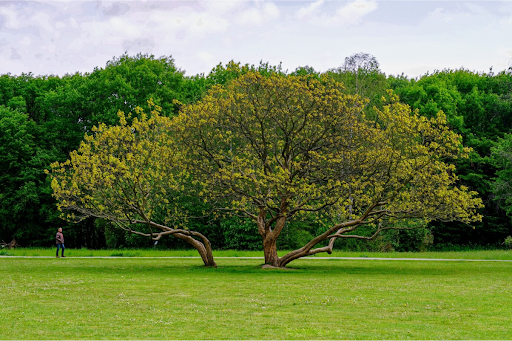Introduction
Linden trees are beautiful, tall trees that can add charm and shade to your landscape. Known for their heart-shaped leaves and sweet-smelling flowers, these trees are pleasing to the eye and beneficial for the environment. When selecting the best linden tree for your garden, it’s essential to explore various species, including the American linden and the European linden. In this article, we will discuss 10 species of linden trees for your landscape, helping you choose the perfect tree for your yard or park.
Some linden trees, like the fiddleleaf linden, can grow quite large, providing excellent shade on hot summer days, while others, such as the Greenspire linden, are smaller and ideal for tighter spaces. Whether you’re looking for a tree that attracts pollinators or one that offers lovely fall colors, there is a linden tree for everyone. These trees also help improve air quality and provide homes for local wildlife. By planting one of these 10 linden tree species, you can enjoy their beauty while creating a healthier environment. Let’s explore the amazing world of linden trees and find out which species will thrive in your landscape!
Understanding Linden Trees
Linden trees, belonging to the Talia genus, are popular choices for landscaping due to their striking appearance and numerous benefits. These deciduous trees are known for their heart-shaped leaves and fragrant yellow flowers that bloom in summer, attracting bees and other pollinators. With over 30 species of linden trees, such as the American linden and the Liliesleaf linden, each variety offers unique qualities to enhance your garden. Linden trees can grow tall, providing excellent shade for picnics or play areas.
Their strong wood makes them durable, while their beautiful foliage adds visual interest throughout the seasons. Understanding the different types of linden trees is essential for choosing the right one for your landscape. In this article, we will explore 10 species of linden trees for your landscape, helping you create a lush and inviting outdoor space that benefits both people and wildlife.
Benefits of Using Linden Trees in Your Landscape
Using linden trees in your landscape offers many great benefits. These beautiful trees are known for their large, heart-shaped leaves that provide plenty of shade, making them perfect for parks and backyards where families like to gather. The fragrant yellow flowers that bloom in summer not only smell wonderful but also attract bees and butterflies, helping support local wildlife.
Linden trees, such as the American linden and littleleaf linden, are also great for improving air quality by absorbing carbon dioxide and releasing oxygen. Their strong wood makes them durable, and they can withstand harsh weather conditions. Additionally, linden trees can add value to your property, creating an inviting and peaceful atmosphere. By choosing from the 10 species of linden trees for your landscape, you can enjoy these benefits while enhancing the beauty of your outdoor space and supporting the environment.
10 Species of Linden Trees
There are many types of linden trees to choose from, making them a fantastic option for your landscape. Here are 10 species of linden trees that you might consider planting. The American linden is a tall tree with a wide canopy that provides great shade. The European linden is known for its strong branches and beautiful flowers. The littleleaf linden is smaller, making it perfect for tight spaces, while the Greenspire linden has a narrow shape, which is ideal for urban areas. The silver linden stands out with its silvery leaves, and the Redmond linden is great for parks.
Other species include the Bastard linden, known for its unique features, and the Siberian linden, which is hardy and can withstand cold weather. The Pyramidalis linden offers a tall, narrow growth habit, while the Native linden supports local wildlife. Each of these 10 species can enhance your garden with beauty and benefits, making them a wonderful addition to any outdoor space!
Silver Linden (Tilia tomentosa)

The Silver Linden (Tilia tomentosa) is a stunning choice for landscapes, known for its silvery-green leaves with fuzzy undersides. When the wind blows, the leaves create a shimmering effect, adding a touch of elegance to gardens and city streets. Growing up to 70 feet tall, this tree provides excellent shade and is highly tolerant of urban pollution, making it perfect for city landscapes. In late spring or early summer, the Silver Linden blooms with small, fragrant flowers that attract bees and other pollinators.
What makes the Silver Linden unique is its thick, reflective leaves, which help it stay cool and drought-resistant. As one of the “10 Species of Linden Trees for Your Landscape,” this species is easy to maintain and offers beauty and functionality. Ideal for anyone looking to create shade, support pollinators, and add natural charm, the Silver Linden is a top choice for outdoor spaces.
Pyramidalis Linden (Tilia cordata ‘Pyramidalis’)
The Pyramidalis Linden (Tilia cordata ‘Pyramidalis’) is a unique type of linden tree that stands out for its tall, narrow shape, making it a great fit for smaller spaces. This tree grows in a column-like form, reaching up to 60 feet in height but only about 15 feet wide, giving it a tidy look that fits well in both gardens and urban landscapes. Its leaves are heart-shaped, green, and turn a lovely yellow in fall, adding seasonal beauty to any space.
Known for being easy to care for, the Pyramidalis Linden is a hardy tree that tolerates a range of soils and can withstand pollution, making it ideal for city environments. It blooms with small, fragrant flowers in early summer that attract bees and other helpful insects. As one of the “10 Species of Linden Trees for Your Landscape,” Pyramidalis Linden brings vertical elegance, color, and pollinator support to any landscape design.
How to Choose the Right Linden Tree for Your Landscape

Choosing the right linden tree for your landscape depends on the space you have and the look you want to achieve. With various linden tree species available, such as the American Linden (Tilia americana) for wide, shady areas or the Pyramidalis Linden (Tilia cordata ‘Pyramidalis’) for narrow spaces, each type offers something unique. Consider how tall and wide you want the tree to grow. Some linden trees, like the Silver Linden (Tilia tomentosa), reach heights of 70 feet, ideal for large areas, while smaller types like Littleleaf Linden (Tilia cordata) fit in compact spaces.
Also, think about seasonal features. Lindens are known for their beautiful heart-shaped leaves, which often turn yellow in fall, and their fragrant summer flowers that attract pollinators like bees. By exploring the “10 Species of Linden Trees for Your Landscape,” you can find the perfect linden that adds shade, beauty, and pollinator support to your outdoor space.
FAQ’s
- What is the American Linden (Tilia americana) good for?
The American Linden is great for large spaces, providing lots of shade with its broad canopy. - How tall does the Littleleaf Linden (Tilia cordata) grow?
Littleleaf Linden typically grows to about 50-70 feet but stays more compact, perfect for smaller areas. - Why is Silver Linden (Tilia tomentosa) popular in cities?
Silver Linden is pollution-tolerant and has reflective, drought-resistant leaves, making it ideal for urban landscapes. - What makes the Pyramidalis Linden (Tilia cordata ‘Pyramidalis’) unique?
This tree has a narrow, columnar shape, fitting well in tight spaces. - Does the European Linden (Tilia × europaea) have special features?
Yes, it has a dense canopy and fragrant flowers, which attract bees and provide shade.
Conclusion
In conclusion, adding a linden tree to your landscape is a fantastic choice for both beauty and function. With so many options, such as the grand American Linden for wide spaces or the elegant Silver Linden with its shimmering leaves, you can find a species that perfectly fits your needs. Each of the “10 Species of Linden Trees for Your Landscape” offers unique benefits, from providing cool shade to attracting helpful pollinators like bees. Lindens are also hardy trees that adapt well to different climates, soils, and even urban areas, making them easy to maintain.
Whether you’re looking for tall, stately trees or compact, narrow varieties, linden trees offer seasonal beauty with heart-shaped leaves and fragrant summer blooms. By choosing the right linden, you’ll add lasting charm and natural support for pollinators to your outdoor space, making your garden or yard a peaceful, beautiful place all year round.
Read More : When is a good time to visit La Paz?

